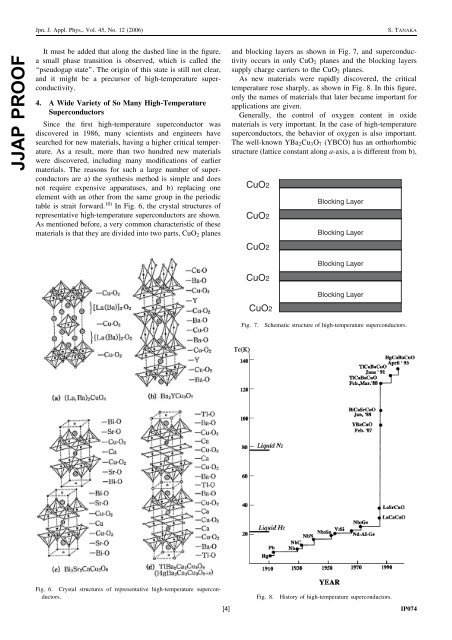High-Temperature Superconductivity - W2agz.com
High-Temperature Superconductivity - W2agz.com
High-Temperature Superconductivity - W2agz.com
Create successful ePaper yourself
Turn your PDF publications into a flip-book with our unique Google optimized e-Paper software.
Jpn. J. Appl. Phys., Vol. 45, No. 12 (2006)<br />
S. TANAKA<br />
JJAP PROOF<br />
It must be added that along the dashed line in the figure,<br />
a small phase transition is observed, which is called the<br />
‘‘pseudogap state’’. The origin of this state is still not clear,<br />
and it might be a precursor of high-temperature superconductivity.<br />
4. A Wide Variety of So Many <strong>High</strong>-<strong>Temperature</strong><br />
Superconductors<br />
Since the first high-temperature superconductor was<br />
discovered in 1986, many scientists and engineers have<br />
searched for new materials, having a higher critical temperature.<br />
As a result, more than two hundred new materials<br />
were discovered, including many modifications of earlier<br />
materials. The reasons for such a large number of superconductors<br />
are a) the synthesis method is simple and does<br />
not require expensive apparatuses, and b) replacing one<br />
element with an other from the same group in the periodic<br />
table is strait forward. 10) In Fig. 6, the crystal structures of<br />
representative high-temperature superconductors are shown.<br />
As mentioned before, a very <strong>com</strong>mon characteristic of these<br />
materials is that they are divided into two parts, CuO 2 planes<br />
and blocking layers as shown in Fig. 7, and superconductivity<br />
occurs in only CuO 2 planes and the blocking layers<br />
supply charge carriers to the CuO 2 planes.<br />
As new materials were rapidly discovered, the critical<br />
temperature rose sharply, as shown in Fig. 8. In this figure,<br />
only the names of materials that later became important for<br />
applications are given.<br />
Generally, the control of oxygen content in oxide<br />
materials is very important. In the case of high-temperature<br />
superconductors, the behavior of oxygen is also important.<br />
The well-known YBa 2 Cu 3 O 7 (YBCO) has an orthorhombic<br />
structure (lattice constant along a-axis, a is different from b),<br />
CuO2<br />
CuO2<br />
CuO2<br />
Blocking Layer<br />
Blocking Layer<br />
CuO2<br />
CuO2<br />
Blocking Layer<br />
Blocking Layer<br />
Fig. 7.<br />
Schematic structure of high-temperature superconductors.<br />
Fig. 6. Crystal structures of representative high-temperature superconductors.<br />
Fig. 8. History of high-temperature superconductors.<br />
[4] IP074














